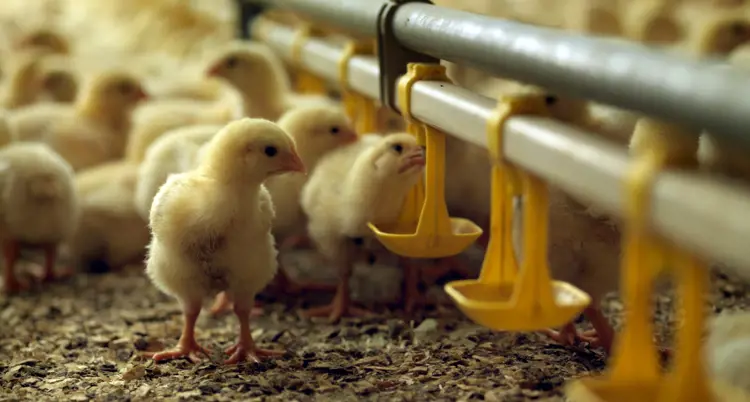Sudden Death Syndrome in Broilers
Sudden death syndrome is of significant economic concern in both commercial and small-scale broiler production. Sudden death syndrome (SDS) is a condition characterized by the acute death of well-nourished and seemingly healthy birds after abrupt and brief flapping of their wings. The exact cause of SDS in broilers remains unknown, but it is thought to be a metabolic disease in which nutrition, genetics, and environment are contributing factors. The birds are often found lying on their backs, hence it is commonly known as “flip-overs”. The condition is reported to be responsible for 1-1.5% of the mortalities in broilers. This condition predominantly affects fast- growing broilers from as early as 4 days old, with a rise in mortalities occurring at 3 to 4 weeks of age, with a higher prevalence observed in males.

This article will discuss the possible causes and preventative measures through management.
Rapid Growth
The selection of broilers for rapid growth and high meat yield may lead to metabolic imbalances and cardiovascular abnormalities. This rapid growth can put a strain on the cardiovascular system, potentially leading to fatal arrhythmias (irregular heartbeat). High-energy diets, particularly those rich in carbohydrates, can overwhelm the metabolic capacity of young birds, potentially contributing to cardiac dysfunction.
The goal of most farms is to grow broilers as fast as possible; however, to reduce the risk of SDS on the farm, farmers must realise the importance of controlling growth, especially in the first 21 days, to allow for the development of organs. A “belly feeding” is a feeding strategy where the growth is controlled in the starter period and grower period, and increased in the finisher period to ease off pressure on developing organs. Graph 1 shows the potential growth line (pink) and the controlled growth curve (blue); the blue line illustrates the controlled growth of broilers.

Graph 1: Illustration of controlled growth of broiler growth
Environmental stressors
Stress also influences SDS. These include high stocking densities, poor ventilation, and sudden noises, which can trigger fatal cardiac events in susceptible birds. A stocking density of 18 birds per square metre in controlled environments and 14 for open-sided houses is associated with high rates of SDS in summer.
Reducing the stocking density can assist in reducing mortalities. Poor ventilation can cause low oxygen levels and high carbon monoxide, ammonia and carbon dioxide, predisposing the birds to develop ascites, which is linked to SDS. Avoiding stressors such as maintenance noise in a broiler house is one of the ways to reduce the occurrence of SDS. All maintenance activities should be carried out when the house is empty.
Late-stage broiler mortalities can be significantly costly since the loss includes the birds as well as the feed and other resources invested in growing them. Controlling the lighting period reduces the intakes and allows for rest time, avoiding metabolic overload and predisposing the birds to SDS.
Treatment
Currently, there is no specific treatment for SDS. However, several management strategies can help reduce its incidence, such as genetic selection of slower-growing broiler breeds can decrease the risk of metabolic and cardiovascular complications.
Providing a balanced diet with appropriate levels of energy, protein, and essential nutrients can support healthy growth and minimize metabolic stress. Notional research suggests that avoiding excessive calcium, phosphorus, and vitamin D3 supplementation can reduce SDS. Introducing feed additives like antioxidants to reduce oxidative stress may be helpful.
|
Cause |
Effect |
Solution |
|
Metabolic |
||
|
Rapid growth rate |
Increased metabolic demand, cardiac stress, and electrolyte imbalances |
Controlled growth management (early feed restriction, slower-growing breeds) |
|
High-energy diets, excess carbohydrate intake |
Metabolic imbalances, acidosis, cardiac arrhythmias |
Dietary modifications (reduced carbo- hydrate levels, optimized micronutrient balance) |
|
Electrolyte imbalances (e.g., low potassium) |
Disrupted cardiac function, increased susceptibility to arrhythmias |
Dietary electrolyte balancing, supple- mentation |
|
Cardiac |
||
|
Underlying cardiac abnormalities (e.g., en- larged heart, altered electrical conductivity) |
Increased risk of fatal arrhythmias |
Genetic selection for improved cardiac health |
|
Environmental |
||
|
Stress (e.g., sudden noises, changes in lighting) |
Triggering of cardiac events in suscepti- ble birds |
Stress reduction through proper man- agement practices (consistent lighting, temperature, minimal disturbances) |
Table 1: A summary of cause and effect and solution to sudden death syndrome .
Conclusion
Although SDS cannot be entirely eradicated, it is possible to significantly reduce its incidence. By understanding the multifactorial nature of SDS and implementing appropriate management strategies, the poultry industry can strive to reduce the impact of this economically significant condition.
Get in touch with your local De Heus Specialist to learn more about Sudden Death Syndrome in Broilers - https://www.deheus.co.za/meet-our-team
